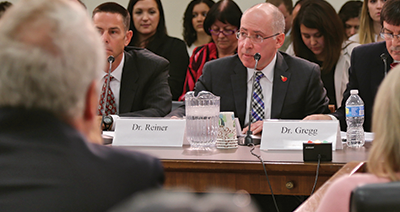Sudden cardiac arrest (SCA), when the heart unexpectedly stops beating, can strike anywhere, anytime. While those with a history of heart disease — such as a previous heart attack, coronary artery disease, or arrhythmia — are most at risk, anyone, even healthy adults or young athletes, can experience SCA. According to a 2015 Institute of Medicine Report, each year almost 400,000 men, women, and children will experience an out-of-hospital sudden cardiac event, with survival rates averaging less than 6 percent.

Those figures are why for the past five years Jonathan Reiner, M.D., professor of medicine at GW’s School of Medicine and Health Sciences, and director of the GW Hospital’s Cardiac Catheterization Lab, has been working to put Automated External Defibrillators (AEDs) in the hands of good Samaritans willing to make a difference.
The bill, HR 4152 – the Cardiac Arrest Survival Act of 2015, is co-sponsored by Pete Olson (R–Texas) and Gerry Connoly (D–Virginia), and is currently making its way through the House Energy and Commerce Committee and the Subcommittee on Health. According to Reiner, the bill has received widespread support, but things on Capitol Hill are never as straightforward as they seem. This is the third time the bill has been introduced.
An AED is a computer, explains Reiner, who specializes in interventional cardiology, cardiac catheterization, and heart attack treatment. It is designed to detect a faulty heart beat and deliver an electric shock to try to restore a normal heart rhythm. Once you place the device’s patches on a patient’s chest, the computer analyzes the heart rhythm. It will not discharge a jolt if it determines the heart is not within a “shockable rhythm.”
“It’s essentially a fool-proof device,” he says. “The only way to make a mistake is by not trying to use a defibrillator on somebody who is having a cardiac arrest. “The clock is ticking,” adds Reiner. “If you resuscitate somebody with a defibrillator shock within one minute of their cardiac arrest, just 60 seconds, the data show that almost everyone survives.” If the time between cardiac arrest and defibrillation passes the 10-minute mark, however, the effort is basically futile. Within those 10 minutes, says Reiner, “survival rates go from virtually everyone to almost nobody.”

In June 2009, Reiner and the GW Heart and Vascular Institute launched ReStart DC in an effort to make defibrillators more available across the city. Ultimately, they distributed 150 defibrillators. When ReStart DC began looking beyond the District’s boundaries, however, they discovered a problem. The laws involving the use of AEDs were vastly different.
In early 2000, the American Heart Association lobbied for laws governing liability protections for businesses and organizations who wanted to initiate an AED program. They were successful. The unintended consequences of that achievement, however, made it something of a hollow victory. Instead of life-saving defibrillators available within a minute or two of anyone in need, the country ended up with a patchwork of laws, each state with its own unique requirements and nuances. That ambiguity meant businesses operating across multiple states often decide it is easier to avoid the risk of liability and not offer the life-saving devices.
“All the bill says is that regardless of what a state’s regulations are, as long as you have a working defibrillator in your place of business, you are protected; and if you are a rescuer, as long as you are using the device with good intent to try to save someone’s life, you are also protected.” The bill, he says, “doesn’t cost the government anything and it doesn’t obligate businesses to do anything they don’t want to do already, but it has the effect of saving thousands of lives.”



